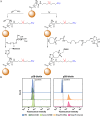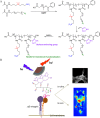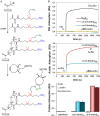Romantic Surfaces: A Systematic Overview of Stable, Biospecific, and Antifouling Zwitterionic Surfaces
- PMID: 30620199
- PMCID: PMC6365910
- DOI: 10.1021/acs.langmuir.8b03360
Romantic Surfaces: A Systematic Overview of Stable, Biospecific, and Antifouling Zwitterionic Surfaces
Abstract
This Feature Article focuses on recent advances in the bioconjugation of surface-bound zwitterionic polymers for biospecific antifouling surfaces. Various approaches for the functionalization of antifouling zwitterionic polymers are systematically investigated, such as chain-end and side-chain functionalization. Side-chain functionalization methods can be further classified as those that are achieved through homopolymerization of custom-synthesized zwitterionic monomers equipped with reactive groups, or those that are achieved via synthesis of random or block copolymers combining different monomers with antifouling functionality and others with reactive groups. Several of the pros and cons of these approaches are outlined and discussed. Finally, some perspective and future directions of research are presented toward long-term stable, generically repelling surfaces that strongly and specifically adhere to a single component in a complex mixture.
Conflict of interest statement
The authors declare no competing financial interest.
Figures











Similar articles
-
Zwitterionic materials for antifouling membrane surface construction.Acta Biomater. 2016 Aug;40:142-152. doi: 10.1016/j.actbio.2016.03.038. Epub 2016 Mar 26. Acta Biomater. 2016. PMID: 27025359 Review.
-
Molecular level studies on interfacial hydration of zwitterionic and other antifouling polymers in situ.Acta Biomater. 2016 Aug;40:6-15. doi: 10.1016/j.actbio.2016.02.030. Epub 2016 Feb 23. Acta Biomater. 2016. PMID: 26923530 Review.
-
Electrodeposition of Zwitterionic PEDOT Films for Conducting and Antifouling Surfaces.Langmuir. 2019 Feb 5;35(5):1126-1133. doi: 10.1021/acs.langmuir.8b01492. Epub 2018 Jul 20. Langmuir. 2019. PMID: 30001621
-
Surface Hydration and Antifouling Activity of Zwitterionic Polymers.Langmuir. 2022 Apr 19;38(15):4483-4489. doi: 10.1021/acs.langmuir.2c00512. Epub 2022 Apr 5. Langmuir. 2022. PMID: 35380850 Review.
-
Surfaces with antifouling-antimicrobial dual function via immobilization of lysozyme on zwitterionic polymer thin films.J Mater Chem B. 2022 Apr 6;10(14):2728-2739. doi: 10.1039/d1tb02597j. J Mater Chem B. 2022. PMID: 35156115
Cited by
-
Self-Assembly of Elastin-like Polypeptide Brushes on Silica Surfaces and Nanoparticles.Biomacromolecules. 2021 May 10;22(5):1966-1979. doi: 10.1021/acs.biomac.1c00067. Epub 2021 Apr 19. Biomacromolecules. 2021. PMID: 33871996 Free PMC article.
-
Design of Polypeptides Self-Assembling into Antifouling Coatings: Exploiting Multivalency.Biomacromolecules. 2022 Sep 12;23(9):3507-3516. doi: 10.1021/acs.biomac.2c00170. Epub 2022 Aug 11. Biomacromolecules. 2022. PMID: 35952369 Free PMC article.
-
Antiviral Polymer Brushes by Visible-Light-Induced, Oxygen-Tolerant Covalent Surface Coating.ACS Omega. 2022 Oct 20;7(43):38371-38379. doi: 10.1021/acsomega.2c03214. eCollection 2022 Nov 1. ACS Omega. 2022. PMID: 36340175 Free PMC article.
-
Fabrication of low-fouling, high-loading polymeric surfaces through pH-controlled RAFT.RSC Adv. 2020 May 27;10(34):20302-20312. doi: 10.1039/d0ra02693j. eCollection 2020 May 26. RSC Adv. 2020. PMID: 35520404 Free PMC article.
-
Electrochemical Detection of Tumor-Derived Extracellular Vesicles on Nanointerdigitated Electrodes.Nano Lett. 2020 Feb 12;20(2):820-828. doi: 10.1021/acs.nanolett.9b02741. Epub 2019 Sep 26. Nano Lett. 2020. PMID: 31536360 Free PMC article.
References
Publication types
LinkOut - more resources
Full Text Sources
Miscellaneous

